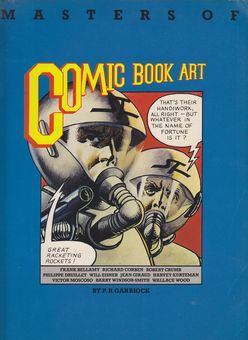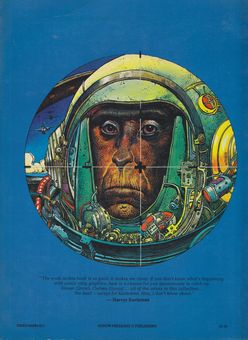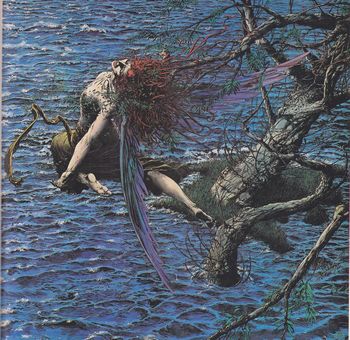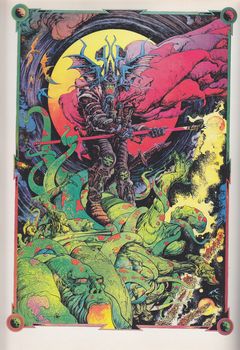Comic Book Art
| série: | Etude Comics |
| dessinateur / scénariste: | Garriock P.R. |
| éditeur: | Aurum Press EO 1978 |
| genre: | Etude |
| classement: | biblio619 |
| date: | 1978 |
| format: | broché |
| état: | TBE |
| valeur: | 10 € |
| critère: | ** |
| remarques: | English book of 120 pages, partly with color pages - the first comic books were simply bound collections of newspaper strips, the new comics were essentially picture versions of the pulps, a form of escapist litterature popular in the 1920's and 1930's - in the comic book, similar to film technique, the highlights of the action are frozen in separate panels allowing the viewer's imagination to fill in the movement - the best comic book artists are those who have developed their own shorthand or style and it is the power of the pictorial conception rather than the text that should inform the narrative (n.b. but only images do not make a good comic book, text is also important) 1) Will Eisner (1917-2005) - Eisner was the first to apply the principle of cutting between camera angles to the rapidly shifting viewpoints of his own panels with lighting effects such as throwing deep shadows, enshrouding a scene in mist or revealing a face with a lighted match all reflecting a cinematic influence - Eisner was known for his famous characters such as: the Hawk, Dollman, Sheena, Blackhawk, etc with the Spirit however, he created a landmark in the evolution of the comic book remembered above all for its splendid imagery, all his characters were always amusingly human but Eisner excelled in the characterization of this female villains - with the Spirit, Eisner proved that comics were capable of good drama with humour, irony and pathos; he moved away from purely escapist fantasy towards a greater psychological realism illustrations in the book: - strips from the Spirit with the wicked heroïne Silk Satin - 4 pages (including the cover pages with the title integrated in an original design into the picture) with the notorious villainess Sand Saref (1950) - other villainous women were: P'Gell and Plaster of Paris 2/ Harvey Kurtzmann (1924-1993) - Kurtzmann influenced two generations of comic book artists with his humour magazine "Mad comics" in 1952 he revealed a talent for satire and has since parodied every facet of American life he was particularly succesful in exposing the abject materialism of the average consumer - he also started to tell war stories in a more realistic way in "frontal line combat" and "two fisted tales" at E.C. comics, Kurtzmann became more of a writer leaving the artwork to artist like Bill Elder, Jack Davis and Wallace Wood among many others - he created with Robert Crumb the underground comics with "Help", he started also "Little Annie Fanny" 1962 in Playboy - illustrations in this book: - strips from "Pot Shot Pete", sherif of Yucca Pucca Gulch satirizing the singing cowboys of the late 40's (1950) - strips from "front line combat" (1952) - strips from "hey look" (1948) - strips from "two fisted tales" (1952) - strips from "Mad" (1953), "Trump" (1957) and "Help" (1962) 3) Frank Bellamy (1917-1976) - Bellamy was one of the first Englishmen in the comic book field to achieve international recognition his high standards and attention to detail have made him an important influence in European comics - he started 1957 in "Eagle" depicting Winston Churchill's life, then continued with "Dan Dare" - his pictures had an almost photographic realism in 1962, he started his own strip and most acclaimed creation: "Heros, the Spartan", then he did draw "Garth" until his death some other strips were: Frazer of Africa, the shepherd king and Marco Polo - illustrations in this book: - strips from "the happy warrior" (1958) = Winston Churchill's life - Dan Dare (1960) - Heros the Spartan (1972) 4) Richard Corben (1940-2020) one of the most original artists in the comic book medium his first creations were: Fantagor (1970), Rowlf and Den in Metal Hurlant (1975) and Bloodstar (1976) - Corben applied the film story-board technique to the comic book, Corben liked to explore the basic theme of good and evil by recreating traditional myths in other-worldly settings with women always portrayed as sublime sexual creatures, Corben gives a fatalistic outlook on the world, mankind being lustful, greedy, violent and doomed to extinction, the most striking feature of his work is however the colour - illustrations in this book: - strips from Den, Fever dreams, Funny world, Rowlf and Bloodstar 5) Barry Windsor-Smith (1949-) - started with Marvel Comics in 1968, influenced by Jack Kirby and inspired by the decorative world of Art Nouveau, continuing his style with a world of florid ornamentalism and elegant design - he was the first to transpose Howard's legend of Conan the Barbarian into comic book - illustrations in this book: - strips from Conan the Barbarian as well as various posters showing either characters or imageries n.b. a good story of Conan was first published in full-colour Humanoïde in 1976: les clous rouges 6) Jean Giraud (1938-2012) - 2 names: Gir as the professional traditional artist and Moebius being the fantasy science fiction artist commenting whyly on the state of human culture - worked first for "Coeurs Vaillants" (strout hearts), worked also with Jijé on Jerry Spring, as Moebius he started the magazine "Hara Kiri" - Gir created 1963 "lieutenant Blueberry" in Pilote (French version of the West) in a scrupulous detailed and precise graphic style inspired by Remington's classic painting of the Old West - Blueberry is a modern anti-hero, brutal and unwashed whose major virtues are his vulnerability, cynicism and ironic sense of humour - "la déviation" (the detour) produced 1973 marked a turning point in Giraud's fantasy strips, Giraud was also one of the founders of "Métal Hurlant" (heavy Metal) - illustrations in this book: - covers from Métal Hurlant - strips from Blueberry (Fort Navajo) - posters of Chihuahua Pearl and Arzach - strips from the "la déviation" 7) Philippe Druillet (1944-) - companion of Giraud as two of the partners in an artist-run company, called "Humanoïdes Associés" - while Giraud is an insolent, subtle a nd ironic artist, Druillet is a tragic poet of the apocalypse, Druillet's work is intensely personal astonishing by the sheer explosive power of the imagery - he started "Lone Sloane" in 1965, joining Pilote 1970, Lone Sloane has become a symbol of modern man, imprisoned in his individuality, wondering whether there is a purpose to his existence; in "Delirius" Sloane finds himself in a decadent world where pleasure is a taxable commodity in every respect - Druillet's stories involve epic battles of good and evil with the powers of evil seeming naturally stronger, these stories often critique on the nature of our society - in "the Night", executed 1975, the fight between good and evil ends however with the victory of the forces of light with the approach of day - each page of Druillet's works is a grandiose poster, vividly coloured and filled with a wealth of minute detail, he was somehow inspired by Lovecraft - illustrations in this book: - strips from Vuzz, Delirius and from the "six voyages de Lone Sloane" 8) Wallace Wood (1927-1981) - Wallace Wood started at E.C. Comics and he became the main science fiction illustrator, America, with its technology of the future, being the natural home of science fiction, Wood worked also with Kurtzmann for "Mad Comics" - Wood was marvellous at depicting imaginary worlds that seem palpably real he revealed the best of himself, his sensivity, brilliant imagination and sense of humour through his creations one of his best works was "T.H.U.N.D.E.R Agents" (with some similarity to James Bond's adventures), he let his imagination entirely uninhibited in underground comics with "my world" expressing seediness, violence and sexual perversion "my world" provided a delightful savage commentary on American way of life - others works include Sally Forth (1976), world of the wizard king (1974) and king of the world (1978) - illustrations in this book: - strips from "Mad Comics" - historical works such as "Anthony and Cleopatra" as well as "Joan of Arc" - strips from "Thunder Agents" and "Chennault's raiders" - strips from "my world" (Pipsqueak papers) and "witzend" - strips on science fiction and fantasy - this chapter contains also a brief article about underground comics which were born on the West Coast of America in the 60's they were the mouthpiece of a generation in revolt against the elders, depicting subjects likely to give offence to the traditional society, the new offset printing made it economically possible to print small runs without the backing of wealthy sponsors the underground comics mostly forwarded the ideas of the new hippie culture 9/ Robert Crumb (1943-) - Crumb began the modern movement in American comics and created a host of unforgettable characters such as Mr. Natural, Fritz the Cat and Schuman the Human, Crumb is more interested in narrative ideas than in experimenting with graphic design - Crumb never really left the underground, preferring his freedom to the lure of financial success - some characters have particularly emerged from Crumb's stories: a) Whiteman, a typical middle-class American with sexual inhibitions b) Angelford McSpade, the African amazon = a wonderfully grotesque version of the Annie Fanny-type innocent c) Mr. Natural, a bald-headed slightly spurious guro, providing the mirror in which Crumb could see himself - Crumb's work has a sincerity and thoughtfulness that merits repeated viewing - illustrations in this book: - strips from "Arcade" (1975), Meatball (1967), Hytone Comix (1971), Zap Comix (1967), Help (1965), "Mr. Natural" (1970) and People's comix (1972) 10/ Victor Moscoso (1936-) - Moscoso created the first full-colour underground comic, he is more concerned with the elements of visual language expressing surreal imagery than with either plot's, characters of social commentary - Moscoso experiments with the notion of perspective exploring a number of disciplines such as lithography and posters, borrowing constantly Walt Disney's characters - illustrations in this book: - strips from "Hocus Pocus" (1970), "Loop de loop" (1970), Zap comix (1971), "Colour" (1971), "Yellow dog" (1968) and "Luna toon" (1968) Conclusion - bibliographies of these 10 artists' works analyzed in this book (detailed publications for each artist) + bibliographies of various studies on comic books with the main ones as follows: - Abel+While, the Funnies, an American idiom (Free Press 1963) - Lob+Sternberg, les chefs-d'oeuvre de la bande dessinée (Planète 1967) - Blanchard, la bande dessinée (Marabout 1969) - Daniels, a history of comic books in America (Outerbridge 1971) - Feiffer, the great comic book Heroes (Penguin 1967) - Empaytaz+Peignot, les copains de votre enfance (Denoel 1963) - D. Gifford, international book of comics (reprint 1984) - Perry+Aldridge, the Penguin book of comics (Penguin 1967) - Steranko, history of comics, 2 volumes (Supergraphics 1970+1972) - Lupoff+Thompson, the comic book (Arlington 1973) - Lacassin, pour un 9ème art, la bande dessinée (10/18 1971) - Moliterni, histoire de la bande dessinée d'expression française (Serg 1972) >> a very good book with especially the portfolios of 10 major artists who have influenced the comic book from its inception to the present days - it gives an overall selection of their best works and a short but clear and concrete analysis about the contents and interpretation of their comic works enclosures - front cover of the book - back cover of the book (Druillet) - the devil's lake by Barry Windsor-Smith (1975) - the Knight of dawn by Philippe Druillet (1975) |
| couvertures: |     |
Copyright 2008 - 2025 G. Rudolf
